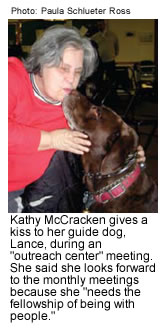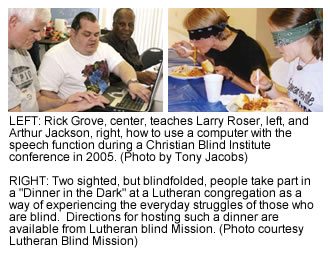by Paula Schlueter Ross

Rev. Dave Andrus, executive director of Lutheran Blind Mission, often cautions well-meaning “sighted” people to ask before trying to help a blind person.
Using the acronym SALE, Andrus advises to stop before you do what you think needs to be done; ask how you can help; really listen to the person’s response; and then evaluate the situation—if you are told that no help is needed but the blind person is in danger, approach that person again, describe what you see, and ask what you can do.
This approach “gives the blind or visually impaired person some control, independence, and self-dignity”—the three things people lose when they lose their sight, Andrus explains.
And he should know: he’s been blind since age 11.
But you won’t find Andrus feeling sorry for himself. As a Lutheran minister and director of the Synod’s blind mission work, Andrus knows the contributions blind people can make—especially to the church.
“People who are blind are no longer passive recipients of materials,” he says. “They are active participants in the work of reaching out and sharing the Gospel.”
Indeed, the ministry has come a long way since The Lutheran Church—Missouri Synod vowed in 1923 to serve blind Lutherans and began by producing devotional materials in Braille.
Sixteen years later the Synod started its Library for the Blind, which offers free, on-loan, Braille, large-type, and audio materials to those with limited or no sight. Today, with more than 6,500 total items available (including The Lutheran Witness), it is the world’s largest Christian lending library for people who are blind, Andrus says.
In 1999, the first “outreach center for the blind” opened in Pittsburgh; today, 58 LCMS congregations have started such centers in 23 states. Blind and visually impaired people are involved in the ministries of all currently operating outreach centers, and actually lead the work at most.
Started with the assistance of Lutheran Blind Mission, the centers are designed to assist blind and low-vision people by offering such things as computer and job training, lessons on reading Braille, workshops on topics of interest, Bible studies and devotions, and a free monthly meal for attendees and their families.
Perhaps most important, though, is the fellowship.
 Kathy McCracken was born blind and attends outreach-center meetings with about 40 others each month at Concordia Lutheran Church in Maplewood, Mo. McCracken and her guide dog, a chocolate labrador named “Lance,” get a free ride from church volunteers, but even if they didn’t, she says she would still somehow make it because “I need the fellowship of being with people.”
Kathy McCracken was born blind and attends outreach-center meetings with about 40 others each month at Concordia Lutheran Church in Maplewood, Mo. McCracken and her guide dog, a chocolate labrador named “Lance,” get a free ride from church volunteers, but even if they didn’t, she says she would still somehow make it because “I need the fellowship of being with people.”
It’s “wonderful,” McCracken says. “It gets you out of the house, you get spiritually uplifted, and I like meeting new people.”
Annually, each blind outreach center touches an average of 25 more visually impaired people—“a group of people oftenforgotten and isolated,” says Lisa L. Watts, director of outreach centers with Lutheran Blind Mission.
“Many blind people feel alone, unloved, and broken by a society that can be cruel and cold,” explains Watts, who has limited vision. Congregations that operate such centers “reach out with love, compassion, resources, support, and, of course, most importantly, the unconditional love of Christ for each of us.” They make a “dramatic difference” in peoples’ lives, she adds.
Watts knows firsthand how the centers can bring people to faith: She became a Lutheran and joined Messiah Lutheran Church in Grand Junction, Colo., after becoming involved in its outreach center, now in its eighth year.
She also has trained as a missionary through the Christian Blind Institute, a 10-course correspondence program supported by Lutheran Blind Mission that prepares blind and low-vision people to reach others for Christ.
 Watts is just one example of someone who came to faith through Lutheran Blind Mission (LBM) and now is a vital part of that ministry, observes Andrus. Because people like her are involved, the work of LBM “continues to grow and expand.”
Watts is just one example of someone who came to faith through Lutheran Blind Mission (LBM) and now is a vital part of that ministry, observes Andrus. Because people like her are involved, the work of LBM “continues to grow and expand.”
The primary focus of the ministry, he says, is “to help blind people see Jesus.” The blind and visually impaired “are everywhere, in every community”—some 12 million strong, according to Andrus, but, because of their isolation, 95 percent of them are “unchurched.”
To raise awareness of—and support for—blind ministry, Lutheran Blind Mission is sponsoring a Synodwide anniversary campaign this year that includes:
- a “Lutheran Blind Mission Sunday” observance in October.
- an “85th Anniversary Thankoffering” in November.
- sales of a commemorative Christmas ornament, available for $15, including shipping.
Congregations also can get involved by:
- offering appropriate worship materials to blind and low-vision members.
- “being a friend” to those with vision problems by offering to take them shopping, help them pay bills, or address their Christmas cards. “They can’t come to you, so you’ve got to approach them,” Andrus says.
- providing financial support to Lutheran Blind Mission, since 2003 an independent mission society that “gives everything away free” and is totally dependent on donors.
For more information about any of these ideas, contact Lutheran Blind Mission, 7550 Watson Road, St. Louis, MO 63119-4409, at (888) 215-2455 or blindmission@blindmission.org. Or, visit its Web site at blindmission.org.





